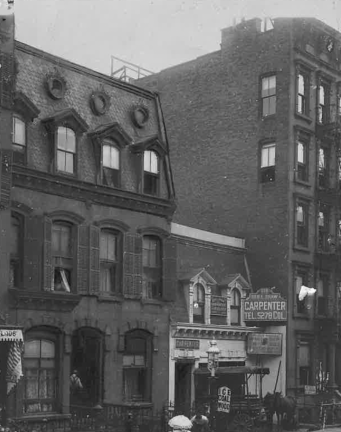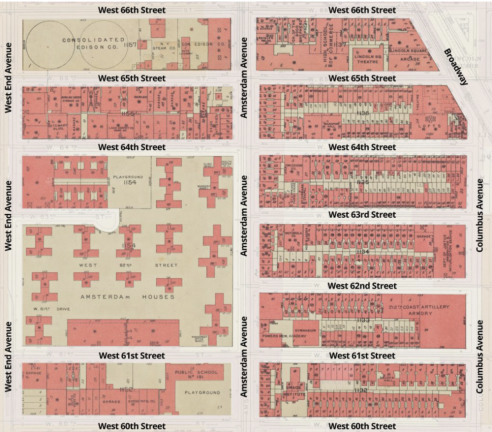Uncovering the Stories of San Juan Hill
Landmark West project looks to rebuild the history of a lost Upper West Side neighborhood


If you’ve never heard of a New York City neighborhood called San Juan Hill, you’re probably not alone. Landmark West, a community-based organization whose mission is to preserve and protect the Upper West Side’s architectural heritage, has high hopes to change that with their new San Juan Hill Project. By diving into the past, they’ve already begun to uncover the many lives of the immigrants who used to live in the neighborhood where Lincoln Center now sits and are well on their way to rebuilding the history of the lost San Juan Hill community.
San Juan Hill spanned from 59th Street to 65th Street and was bound by West End and Amsterdam Avenues (though its exact boundaries are hard to determine) before it was wiped out by a sweep of urban renewal projects in the 1950s and the construction of Lincoln Center began.
Besides the occasional reference to San Juan Hill in “West Side Story” (which used the few days before San Juan Hill was demolished as a backdrop), the neighborhood is not often acknowledged, and rarely remembered, even by those who live there today. While you might be able to pick up a book on the history of Fifth Avenue, there’s no definitive book on San Juan Hill, Executive Director of Landmark West Sean Khorsandi pointed out, and much less is known about its history than that of other NYC neighborhoods, perhaps because it was formerly designated as a “slum.”
“People talked about this area as a ‘slum,’ people talked about this as a ‘red light district,’” Khorsandi said. “But it wasn’t just a slum area. There were lots of social institutions, the first YMCA for African Americans in New York was here, there were a lot of places for orphaned children, and many churches and high schools.”
The Project’s Beginnings
The San Juan Hill Project began when Khorsandi and his colleagues started to wonder why the San Juan Hill area was “partitioned off” to urban planners during the 1950s. They began their quest to find out what the neighborhood looked like and who lived on its streets.
“We started digging up the historic maps and going block by block, building by building, so we wouldn’t just have to talk in generalities forever and so we could talk about San Juan Hill on its own merits and its own meaning in its day ... there were people whose whole lives and communities were there,” Khorsandi said.
With the help of New York State Senator Brad Hoylman, former New York City Council Member Ben Kallos and the City Council’s Cultural Immigrant Initiative, Landmark West has begun to piece together, block by block, the buildings, stories, and people of San Juan Hill. The team conducted research on the buildings occupying six city blocks, between 60th and 66th Streets on Amsterdam and Columbus.
“Who was the architect? What year was it built? What style was it? Who was the original owner? And that’s just the basics to get started,” Khorsandi said in explaining some of the questions the team hoped to answer.
In order to find out who lived in the buildings of San Juan Hill, they then turned to census records.
“In April, the government released the 1950 census ... the census gets released to the public on a 72-year lag so in April of 2022 we were able to finally look at the 1950 census,” he said. “This was exciting because it was the most recent census right before [San Juan Hill] was demolished.”
While there is no record of the 1890 census (a fire is said to have destroyed the 1890 records), the team looked at the 1900, 1910, 1920, 1930, 1940 and 1950 census and was able to analyze the number of heads of households, roomers, and boarders who were immigrants. By clicking on any building on the project’s website, you can see these numbers, in addition to the immigrants’ countries of origin.
“What was clear in all of this was that it was always a heavily European area,” he said. “This was always an immigrant district, and over the years it became more and more diverse and more crowded with immigrants.”
Architectural Historian
Landmark West continues to work with architectural historian Sarah Bean Apmann to uncover the stories of San Juan Hill, as they hope to expand their research in the near future to include more city blocks in the area. Apmann said she immediately jumped on board when she first heard about the San Juan Hill Project.
“I don’t always get to research people ... I’m often dealing with just the building and the style and its significance,” Apmann said. “With this project, I really got to look at the people who were there.”
One building in particular struck Apmann’s interest as she was conducting research.
“In the 1950 census, I found this one building, which if I remember correctly used to be a row house and it became a boarding house which was very common,” she said. “This one boarding house was all Japanese immigrants, and this is right after World War II.”
Landmark West is hosting a Zoom event on Tuesday June 28 from 6-7 p.m. where Apmann will guide viewers through the history of the neighborhood and share some of the stories the team has uncovered.
“This is part of our collective history that’s been lost,” Khorsandi said. “Hopefully this is a platform where we can allow more voices and people who used to live here can hopefully come back and contribute some of their stories.”
“We’re not trying to get rid of Lincoln Center,” Khorsandi added. “We’re just trying to respect the past and understand this neighborhood a little bit better.”